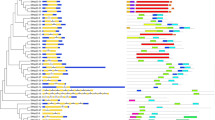Abstract
A genetic analysis of heat shock protein (HSP) synthesis was performed in seedling leaf tissue of two maize inbred lines, their F1 hybrid and F2 progeny. Protein synthesis following a high temperature treatment was visualized by [35S]-methionine in vivo labelling and two-dimensional gel electrophoresis. The parental lines' HSP synthesis patterns revealed both qualitative and quantitative polymorphisms implicative of differences in HSP structural genes and regulatory factors. The F1 hybrid HSP profile indicated that synthesis of all parental HSPs conformed to dominant inheritance patterns, including complete dominance, over-dominance and co-dominance. Alleles for six low-molecularweight HSPs in F2 progeny assorted according to typical 3∶1 Mendelian ratios for dominant gene expression. There is evidence for unlinked gene loci of four different HSP gene pairs, but data for three other HSP gene pairs were inconclusive, perhaps reflecting linkage for one pair and complex regulatory factor interactions for the other two pairs of genes. These results clearly indicate the existence of genetic variability in HSP synthesis and emphasize the potential of partitioning their roles in thermal tolerance using genetic and molecular analyses.
Similar content being viewed by others
References
Bahrman N, Damerval C (1989) Linkage relationships of loci controlling protein amounts in maritime pine (Pinus pinaster Ait.). Heredity 63:267–274
Blum A (1985) Breeding crop varieties for stress environments. CRC Crit Rev Plant Sci 2:199–238
Damerval C, Vienne D de, Zivy M, Thiellement H (1986) Technical improvements in two-dimensional electrophoresis increase the level of genetic variation detected in wheat-seedling proteins. Electrophoresis 7:52–54
Damerval C, Hebert Y, Vienne D de (1987) Is the polymorphism of protein amounts related to phenotypic variability? A comparison of two-dimensional gel electrophoresis data with morphological traits in maize. Theor Appl Genet 74:194–202
Dietrich PS, Bouchard RA, Casey ES, Sinibaldi RM (1991) Isolation and characterization of a small heat shock gene from maize. Plant Physiol 96:1268–1276
Fender SE, O'Connell MA (1989) Heat shock protein expression in thermotolerant and thermosensitive lines of cotton. Plant Cell Rep 8:37–40
Fender SE, O'Connell MA (1990) Expression of the heat shock response in a tomato interspecific hybrid is not intermediate between the two parental responses. Plant Physiol 93:1140–1146
Frova C, Gorla MS (1993) Quantitative expression of maize HSPs: genetic dissection and association with thermotolerance. Theor Appl Genet 86:213–220
Frova C, Taramino G, Binelli G, Ottaviano E (1988) Heat-shock protein variability in maize. Maydica 33:65–76
Goping IS, Frappier JR, Walden DB, Atkinson BG (1991) Sequence identification and characterization of cDNAs encoding two different members of the 18kDA heat shock family of Zea mays L. Plant Mol Biol 16:699–711
Gottlieb LD, Vienne D de (1988) Assessment of the pleiotropic effects of a gene subsititution in pea by two-dimensional gel polyacrylamide gel electrophoresis. Genetics 119:705–710
Jorgensen JA, Nguyen HT (1994) Isolation, sequence and expression of a cDNA encoding a class I heat shock protein (HSP 17.2) in maize. Plant Sci 97:169–176
Jorgensen JA, Weng J, Ho T-HD, Nguyen HT (1992) Genotypespecific heat shock proteins in two maize inbreds. Plant Cell Rep 11:576–580
Jorgensen JA, Rosenow DT, Nguyen HT (1993) Genotypic comparison of heat shock protein synthesis in sorghum. Crop Sci 33:638–641
Krishnan M, Nguyen HT, Burke JJ (1989) Heat shock protein synthesis and thermal tolerance in wheat. Plant Physiol 90:140–145
Leonardi A, Damerval C, Vienne D de (1988) Organ-specific variability and inheritance of maize proteins revealed by two-dimensional electrophoresis. Genet Res 52:97–103
Leonardi A, Damerval C, Hebert Y, Gallais A, Vienne D de (1991) Association of protein amount polymorphism (PAP) among maize lines with performances of their hybrids. Theor Appl Genet 82:552–560
Lin C-Y, Roberts JK, Key JL (1984) Acquisition of thermotolerance in soybean seedlings. Plant Physiol 74:152–160
Mans RJ, Novelli GD (1961) Measurement of the incorporation of radioactive amino acids into protein by a filter disk method. Arch Biochem Biophys 94:48–53
Marmiroli N, Lorenzoni C, Stanca AM, Terzi V (1989) Preliminary study of the inheritance of temperature stress proteins in barley (Hordeum vulgare L.). Plant Sci 62:147–156
Neuffer MG (1982) Growing maize for genetic purposes. In: Sheridan WF (ed) Maize for biological research. Plant Mol Biol Assoc Press, Charlottesville, V., pp 19–30
Ottaviano E, Sari Gorla M (1988) Selecting cultivars for resistance to high and low temperatures In: Biotechnology in tropical crops improvement. Proceedings of the International Biotechnology Workshop ICRISAT, Hyderabad, India pp 97–105
Ottaviano E, Sari Gorla M, Pe E, Frova C (1991) Molecular markers (RFLPs and HSPs) for the genetic dissection of thermotolerance in maize. Theor Appl Genet 81:713–719
Ougham HJ, Stoddart JL (1986) Synthesis of heat-shock protein and acquisition of thermotolerance in high-temperature tolerant and high-temperature susceptible lines of Sorghum. Plant Sci 44:163–167
Riabowol KT, Mizzen LA, Welch WJ (1988) Heat shock is lethal to fibroblasts microinjected with antibodies against HSP70. Science 242:433–436
Sanchez Y, Lindquist S (1990) Hsp 104 required for induced thermotolerance. Science 248:1112–1115
Skinner MK, Griswold MD (1983) Fluorographic detection of radioactivity in polyacrylamide gels with 2,5-diphenyloxazole in acetic acid and its comparison with existing procedures. Biochemistry 209:281–284
Vienne D de, Gottlieb LD (1990) Comparison of leaflets and tendrils in wild-type and homeotic mutant morphs of pea by two-dimensional electrophoresis of proteins. J Hered 81:117–122
Vienne D de, Leonardi A, Damerval C (1988) Genetic aspects of variation of protein amounts in maize and pea. Electrophoresis 9:742–750
Vierling E (1991) The roles of heat shock proteins in plants. Annu Rev Plant Physiol Plant Mol Biol 42:579–620
Vierling RA, Nguyen HT (1990) Heat-shock protein synthesis and accumulation in diploid wheat. Crop Sci 30:1337–1342
Welch WJ (1993) How cells respond to stress. Sci Am 268 (May):56–64
Zivy M, Thiellement H, Vienne D de, Hofmann J-P (1984) Study on nuclear and cytoplasmic genome expression in wheat by two-dimensional gel eletrophoresis. Theor Appl Genet 68:335–345
Author information
Authors and Affiliations
Additional information
Communicated by H. F. Linskens
Rights and permissions
About this article
Cite this article
Jorgensen, J.A., Nguyen, H.T. Genetic analysis of heat shock proteins in maize. Theoret. Appl. Genetics 91, 38–46 (1995). https://doi.org/10.1007/BF00220856
Received:
Accepted:
Issue Date:
DOI: https://doi.org/10.1007/BF00220856




